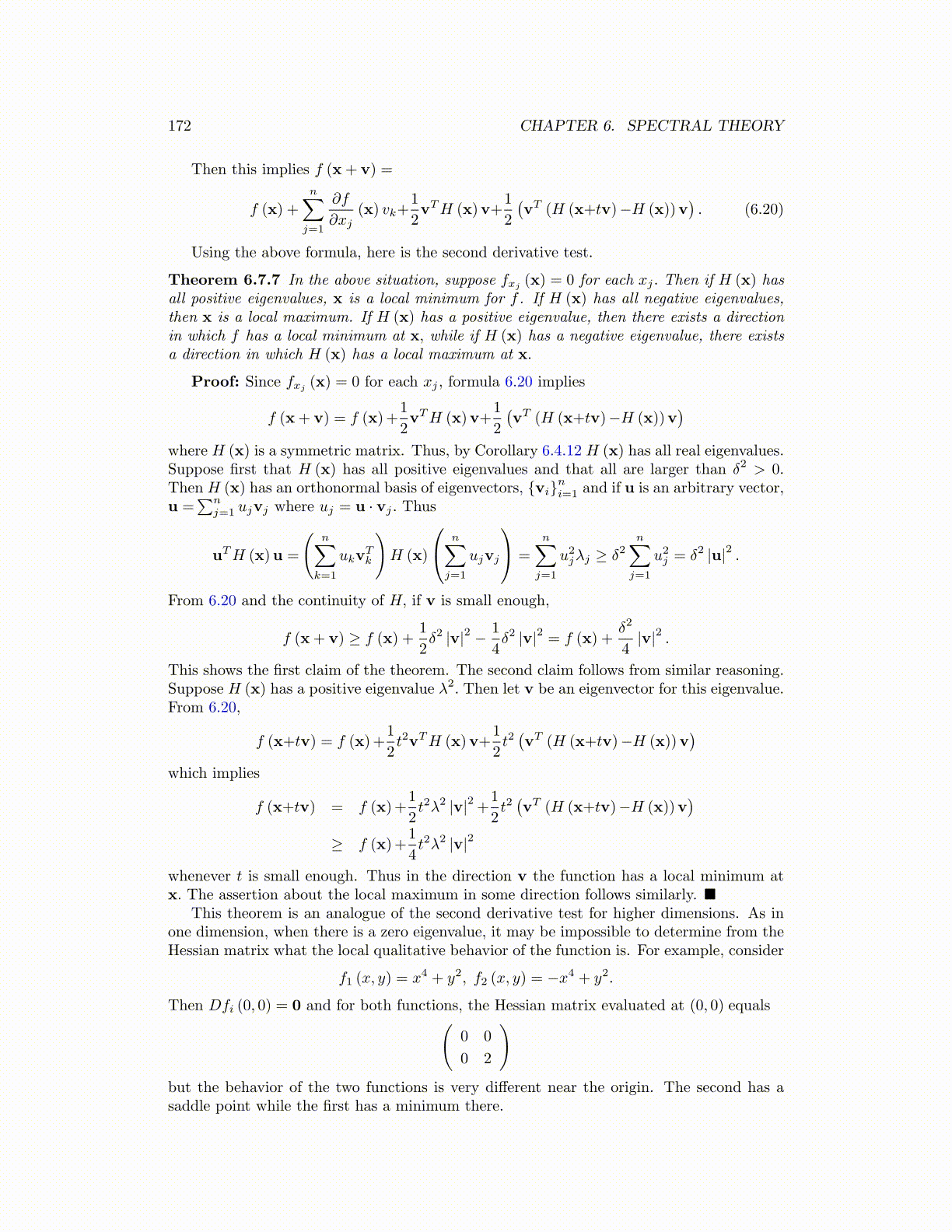
172 CHAPTER 6. SPECTRAL THEORY
Then this implies f (x+ v) =
f (x) +
n∑j=1
∂f
∂xj(x) vk+
1
2vTH (x)v+
1
2
(vT (H (x+tv)−H (x))v
). (6.20)
Using the above formula, here is the second derivative test.
Theorem 6.7.7 In the above situation, suppose fxj(x) = 0 for each xj . Then if H (x) has
all positive eigenvalues, x is a local minimum for f . If H (x) has all negative eigenvalues,then x is a local maximum. If H (x) has a positive eigenvalue, then there exists a directionin which f has a local minimum at x, while if H (x) has a negative eigenvalue, there existsa direction in which H (x) has a local maximum at x.
Proof: Since fxj (x) = 0 for each xj , formula 6.20 implies
f (x+ v) = f (x)+1
2vTH (x)v+
1
2
(vT (H (x+tv)−H (x))v
)where H (x) is a symmetric matrix. Thus, by Corollary 6.4.12 H (x) has all real eigenvalues.Suppose first that H (x) has all positive eigenvalues and that all are larger than δ2 > 0.Then H (x) has an orthonormal basis of eigenvectors, {vi}ni=1 and if u is an arbitrary vector,u =
∑nj=1 ujvj where uj = u · vj . Thus
uTH (x)u =
(n∑
k=1
ukvTk
)H (x)
n∑j=1
ujvj
=
n∑j=1
u2jλj ≥ δ2n∑
j=1
u2j = δ2 |u|2 .
From 6.20 and the continuity of H, if v is small enough,
f (x+ v) ≥ f (x) +1
2δ2 |v|2 − 1
4δ2 |v|2 = f (x) +
δ2
4|v|2 .
This shows the first claim of the theorem. The second claim follows from similar reasoning.Suppose H (x) has a positive eigenvalue λ2. Then let v be an eigenvector for this eigenvalue.From 6.20,
f (x+tv) = f (x)+1
2t2vTH (x)v+
1
2t2(vT (H (x+tv)−H (x))v
)which implies
f (x+tv) = f (x)+1
2t2λ2 |v|2 +1
2t2(vT (H (x+tv)−H (x))v
)≥ f (x)+
1
4t2λ2 |v|2
whenever t is small enough. Thus in the direction v the function has a local minimum atx. The assertion about the local maximum in some direction follows similarly. ■
This theorem is an analogue of the second derivative test for higher dimensions. As inone dimension, when there is a zero eigenvalue, it may be impossible to determine from theHessian matrix what the local qualitative behavior of the function is. For example, consider
f1 (x, y) = x4 + y2, f2 (x, y) = −x4 + y2.
Then Dfi (0, 0) = 0 and for both functions, the Hessian matrix evaluated at (0, 0) equals(0 0
0 2
)but the behavior of the two functions is very different near the origin. The second has asaddle point while the first has a minimum there.